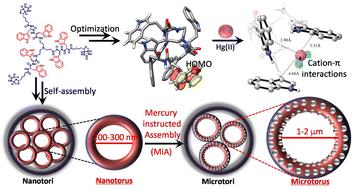Our official English website, www.x-mol.net, welcomes your
feedback! (Note: you will need to create a separate account there.)
Mercury-instructed assembly (MiA): architecting clathrin triskelion-inspired highly functional C3-symmetric triskelion nanotorus functional structures into microtorus structures
Nanoscale ( IF 5.8 ) Pub Date : 2022-06-23 , DOI: 10.1039/d2nr01524b Khushboo Kesharwani 1 , Ramesh Singh 1 , Nikunj Kumar 2 , Narendra Singh 3 , Puneet Gupta 2 , Khashti Ballabh Joshi 1
Nanoscale ( IF 5.8 ) Pub Date : 2022-06-23 , DOI: 10.1039/d2nr01524b Khushboo Kesharwani 1 , Ramesh Singh 1 , Nikunj Kumar 2 , Narendra Singh 3 , Puneet Gupta 2 , Khashti Ballabh Joshi 1
Affiliation

|
To detect heavy metal toxicity using self-assembled nanostructures, a clathrin triskelion-inspired highly functional C3-symmetric trimerized biotinylated di-tryptophan peptide was used. This triskelion peptide is known to self-assemble into nanotorus-like structures and can therefore act as a nanocage for various analytes. In this work, in addition to spectroscopy, force and electron microscopy were successfully used to detect the effect of toxic metal ions such as zinc, cadmium, and mercury by exploiting the change in the nanotorus morphology. Different concentrations of mercury led to the expansion of nanotorus structures into microtori. Therefore, we provide a unique application of heavy metal toxicity by utilizing “material nanoarchitectonics” to architect nanotorus structures into higher-order microtorus structures, as instructed by mercury. Such a strategy can make heavy metal sensing easier for materials scientists and open new avenues for biomedical/environmental science applications.
中文翻译:

Mercury-instructed assembly (MiA):将网格蛋白 triskelion 启发的高功能 C3 对称 triskelion nanotorus 功能结构构建成 microtorus 结构
为了使用自组装纳米结构检测重金属毒性,受网格蛋白 triskelion 启发的高功能C 3使用对称三聚化生物素化双色氨酸肽。众所周知,这种 triskelion 肽可以自组装成类似纳米环的结构,因此可以作为各种分析物的纳米笼。在这项工作中,除了光谱学之外,力显微镜和电子显微镜还成功地利用纳米环形态的变化来检测有毒金属离子(如锌、镉和汞)的影响。不同浓度的汞导致纳米环结构扩展为微环。因此,我们按照汞的指示,利用“材料纳米结构”将纳米环结构构建成更高阶的微环结构,从而提供重金属毒性的独特应用。
更新日期:2022-06-23
中文翻译:

Mercury-instructed assembly (MiA):将网格蛋白 triskelion 启发的高功能 C3 对称 triskelion nanotorus 功能结构构建成 microtorus 结构
为了使用自组装纳米结构检测重金属毒性,受网格蛋白 triskelion 启发的高功能C 3使用对称三聚化生物素化双色氨酸肽。众所周知,这种 triskelion 肽可以自组装成类似纳米环的结构,因此可以作为各种分析物的纳米笼。在这项工作中,除了光谱学之外,力显微镜和电子显微镜还成功地利用纳米环形态的变化来检测有毒金属离子(如锌、镉和汞)的影响。不同浓度的汞导致纳米环结构扩展为微环。因此,我们按照汞的指示,利用“材料纳米结构”将纳米环结构构建成更高阶的微环结构,从而提供重金属毒性的独特应用。











































 京公网安备 11010802027423号
京公网安备 11010802027423号